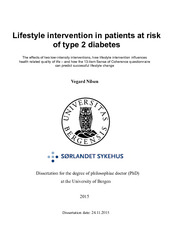| dc.description.abstract | Background: The global prevalence of type 2 diabetes (T2D) is rapidly increasing, linked to the epidemic of obesity and inactivity. There is substantial research evidence for prevention of T2D by lifestyle interventions in high-risk individuals. Less comprehensive lifestyle interventions, or population-based strategies, are needed for the more than half of Europeans at risk of T2D. Two low-intensity interventions in adult Norwegians at risk of T2D were tested in a randomised, controlled design. Methods: Individuals at high risk of T2D were identified by general practitioners (GPs) using the seven-item “Finnish Diabetes Risk Score” (FINDRISC) and referred to the local hospital. A thorough first consultation with the study physician focused on delivering a simple, clear and true message about the importance of the individual’s own efforts regarding both T2D and general health. Participants were randomly assigned to an “individual physician group” (IG) or an “individual plus interdisciplinary group” (IIG) for an 18-month follow-up. Participants in the IG and IIG groups consulted the study physician every six months. In addition, the IIG group participated in an interdisciplinary group-based programme (≤ 10 participants, eight times (five hours per day)) over a period of three months. Outcome measures were changes in lifestyle according to established goals that have been shown to reduce incidence of T2D and to improve health. Furthermore, the influence of lifestyle changes on health-related quality of life (HRQOL) was assessed by Short Form 36 (SF-36), and the predictive ability for successful lifestyle change of the score of the Sense of Coherence (SOC) questionnaire at baseline was explored. Findings: Two hundred and thirteen participants, 50% men, were included in the study, of whom 182 (85%) completed it. At baseline, their mean age was 46.5 years (SD 11 years), their mean BMI was 36.8 (SD 6), 90% were obese, 60% had an unhealthy diet, more than 50% had poor aerobic capacity, and 25% smoked daily. The participants at baseline reported clinically important lower HRQOL compared with the general Norwegian population. The 15% of subjects who dropped out differed significantly at baseline from the completers, with an even higher frequency of unhealthy lifestyle characteristics, an even lower HRQOL, a younger age, and reported clinically significantly lower SOC scores. From baseline to follow-up, there were no statistically significant additional effects or trends of group intervention on lifestyle change. Of all included participants, one in four achieved a clinically important weight loss, one in five achieved a clinically important improvement in aerobic capacity and one in eight reached both goals, regardless of group allocation. Reaching the two most important goals - i.e., a 5% weight loss and 10% improved aerobic capacity, was defined as a successful lifestyle change, was achieved by 26 participants and was best predicted by a high baseline SOC score. Of these 26 participants, one was in the lowest SOC tertile, four were in the medium tertile and 21 were in the highest tertile. In the whole study population, no clinically important change in mean HRQOL scores was seen from baseline to follow-up. However, a moderate or large clinical improvement in HRQOL was achieved by one in three participants, best determined by a small weight loss combined with a small improvement in aerobic capacity. Conclusions: Subjects referred from GPs for being at risk of T2D had surprisingly high BMI, reported a high prevalence of unhealthy lifestyle parameters and had markedly lower HRQOL than the general Norwegian population. Clinically important healthy lifestyle changes could be achieved with modest clinical efforts. A group intervention yielded no additional effects. Among the observed lifestyle changes, a small weight loss and a small improvement in aerobic capacity were best correlated with improved HRQOL. The baseline SOC score can predict a successful lifestyle change, and we recommend that health care professionals use this score to screen all patients on one occasion. The SOC score may increase the health care professionals’ awareness of the patients’ mastery levels and thereby improve the chances of important future health outcomes. It can assist them to achieve an advantageous categorizing of their patients, which can be important for the choice of further treatment for those patients. | en_US |
